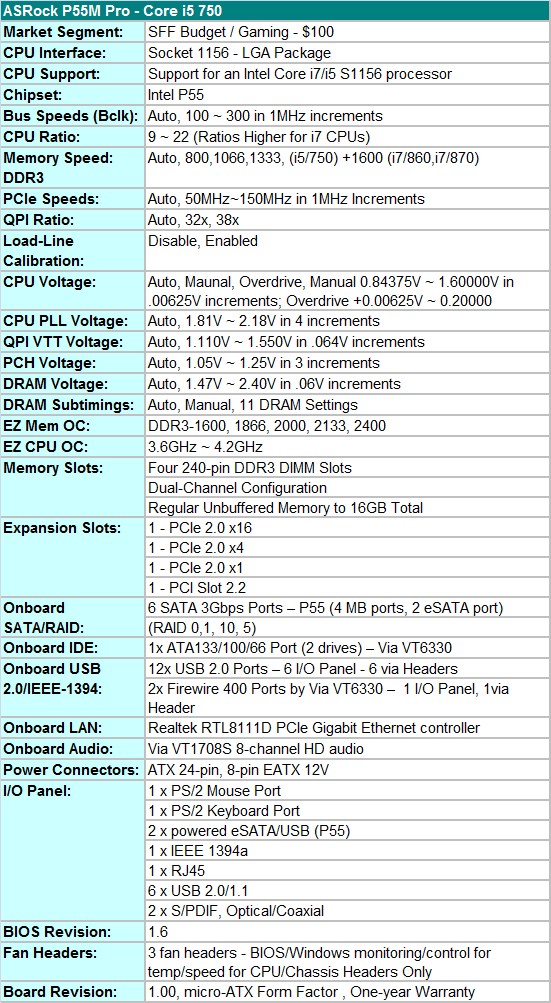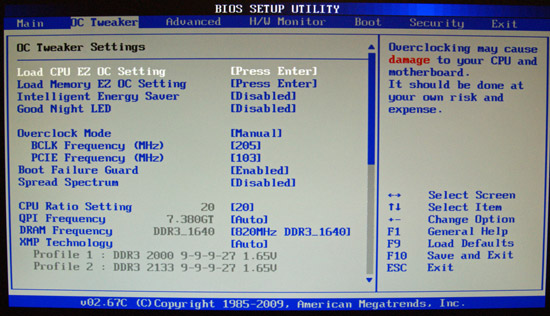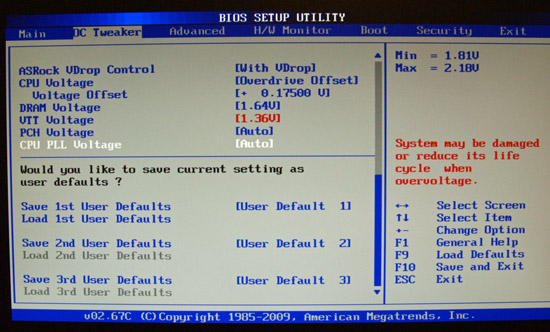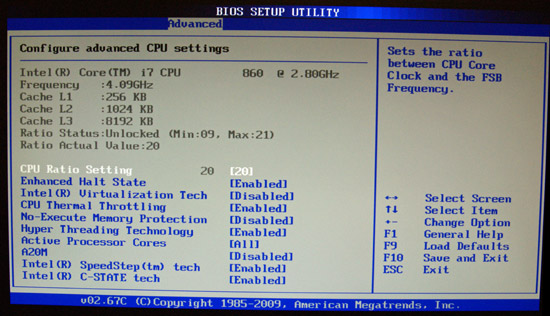Budget Micro-ATX P55 Faceoff: Gigabyte GA-P55M-UD2 and ASRock P55M Pro
by Gary Key on October 5, 2009 12:30 PM EST- Posted in
- Motherboards
Next up is ASRock’s P55M Pro. You can purchase this board for around $100.
ASRock P55M Pro Feature Set

ASRock includes a full featured set of components like the Via VT1708S HD audio codec, Realtek RTL8111D Gigabit LAN controller, Via VT6330 IDE/IEEE 1394a combo chipset, powered eSATA/USB ports on the I/O panel, and full support for the Core i7/i5 S1156 processor series.
ASRock also includes a limited accessories bundle. You get the standard rear I/O panel cover along with 1 x IDE cable, 1 x Floppy cable, 2 x SATA cables, 1 x SATA power cables, an informative manual and quick installation guide, and software CD. We understand the need to cut costs where possible to meet a $100 price target, but including at least one USB 2.0/IEEE 1394a bracket for the headers would have been appreciated.
BIOS
ASRock has designed a BIOS that emphasizes quick auto overclock settings using their CPU or Memory presets rather manually overclocking the board. The breadth of granular BIOS settings in the Gigabyte UD2 board is just not available in the P55M Pro . The BIOS is setup for general overclocking duties and includes the typical P55 settings: CPU multiplier, PCI-E bus, Bclk frequency, memory multipliers, and important voltage options needed for overclocking.
ASRock includes Load Load-Line Calibration (LLC), or they refer to it as With or Without Vdrop. LLC will help to eliminate line droop on the VCore line, but also will cause VCore to overshoot set values when under load. We recommend having LLC disabled in most situations, but if you have to reach a certain overclock for benchmarking, then you should probably enable it. In our case, we enabled when overclocking above 3.8GHz since Vdrop was around -0.05V under load in most cases.
One strength of the BIOS is the auto OC settings that will quickly set the board up for overclocking your memory or CPU to a preset level. Both settings worked well with us favoring the CPU settings as the memory setting at 2133/2400 would drop the CPU multiplier to 13x~15x, resulting in CPU speeds lower than stock with Turbo disabled.
Our only problem with the CPU OC setup is that memory speeds would sometime drop below the capability of our kits with memory speeds running in the 1200MHz range. Those speeds actually do not penalize application performance by more than a couple of percent, but timings followed the SPD of the module. If the SPD is not setup properly, you could end up with CAS 9/10 settings at DDR3-1200. It is easy enough to change them but you end up defeating the purpose of a quick OC.
Voltages tended to range on the high side with the CPU auto OC settings. We understand the reasoning as the ranges needed to ensure stability across a wide variety of processor capabilities require running VCore/VTT a little higher than our CPU’s capabilities. This is the one drawback to preset settings utilized by Gigabyte and ASRock instead of auto overclocking routines based on actual component capabilities that ASUS utilizes. The good news is that on the CPU side, our system always reached the presets and was perfectly stable. Using the memory presets above DDR3-2000 resulted in a few lockups, especially with memory that had not been tested by ASRock.
ASRock has finally implemented BIOS flashing within the BIOS. Instant Flash can read files directly from a USB flash or hard drive making BIOS updating a simple and safe procedure. We tried this feature 30 times as part of our testing routine and it never failed.
We did have a couple of slight disappointments with the BIOS. In the voltage setting options, ASRock does not provide granular voltage settings in the same way that Gigabyte does on the UD2 board. The settings provided will allow for quick and easy overclocks to the 4.1GHz range. Practically speaking, that is probably a level we would not exceed in a 24/7 desktop to be honest.
However, it was a limiting factor in overclocking this board compared to the Gigabyte offering. The main culprit was the lack of VTT voltages between 1.36V and 1.42V. We feel that exceeding 1.40VTT could create a long term problem with Lynnfield CPUs. Intel’s guidance is still 1.35V as the recommended maximum, if not lower in most cases with these CPUs. We needed around 1.39V on VTT to ensure stable operation with our processors above 4.1GHz, we just would not run the 1.42V setting in the ASRock BIOS on air-cooling for performance improvements that would be minor on a daily basis.
BIOS Information
Let’s take a brief visual look at the BIOS.














55 Comments
View All Comments
mfs - Friday, March 26, 2010 - link
how do you get 4 phase on the GA-P55M-UD2? looks like 6 by the photos? bit-tech says 6 too.andersbranderud - Friday, March 12, 2010 - link
Does anyone have any experiences with overclocking an i7-860 on this motherboard with 1333 mhz or 1600 mhz ram.In that case give me some more details.
Thanks!
Anders Branderud
bloganders.blogspot.com
zoggy - Thursday, February 18, 2010 - link
Was looking at picking up GA-P55M-UD2 for a HTPC, going to pair it with Core i7 860 and a ATI HD 5000 series card. Wanted to know if there was any problems with this board to do the bit-streaming of HD audio or if the UD4 would be better suited?Hrel - Friday, October 23, 2009 - link
Pictures of the Motherboard BIOS, THANK YOU SO MUCH!maomao0000 - Sunday, October 11, 2009 - link
http://www.myyshop.com">http://www.myyshop.comQuality is our Dignity; Service is our Lift.
Myyshop.com commodity is credit guarantee, you can rest assured of purchase, myyshop will
provide service for you all, welcome to myyshop.com
Air Jordan 7 Retro Size 10 Blk/Red Raptor - $34
100% Authentic Brand New in Box DS Air Jordan 7 Retro Raptor colorway
Never Worn, only been tried on the day I bought them back in 2002
$35Firm; no trades
http://www.myyshop.com/productlist.asp?id=s14">http://www.myyshop.com/productlist.asp?id=s14 (Jordan)
http://www.myyshop.com/productlist.asp?id=s29">http://www.myyshop.com/productlist.asp?id=s29 (Nike shox)
Googer - Sunday, October 11, 2009 - link
I don't see how the inclusion of something can be seen as a negative. I am sure there are a few users who still depend on a floppy drive from time to time (retro dos gamers, some drivers, and archiving old files) and it's presence has little to negative impact on the actual usability, functionality, or performance of the motherboard.As for my self, I have tried several times to remove my drive, only to have someone or myself find an unexpected need for it a few months later. So I still keep it installed but the drive it's self remains disabled in the bios until I actually need it. Having it enabled has no noticeable impact on my P4 based system.
Serveo - Friday, October 9, 2009 - link
Hi Gary,Nice review. I am planning to buy a p55 mATX board. There are some on the market but mostly they support only 16x & 4x GPU and thats a pity.
Only the Gigabyte GA-P55M-UD4 and ASUS Maximus III Gene support sli/cross at 8x mode. I would like to your review about these boards soon. The price for the GA-P55M-UD4 is available around € 130.- incl. VAT and the Maximus III Gene around € 170.- incl VAT.
Thats why I probably go for the Gigabyte due to the price an the board colors, but the board layout has some fails and according to the review at bit-tech.net the performance is not that good.
Gary when can I aspect the review about these boards? Or which of these two board would you advice?
Awnold - Wednesday, October 7, 2009 - link
Hi Gary,Great article! Looking at other user's experience w/ the Gigabyte board, I've seen a number of complaints w/ memory compatibility (e.g., Newegg's reviews). Would you mind posting the part #'s of the different memories you tested this board with?
I did see your comment that the F4 BIOS improved memory compatibility, but to my knowledge they haven't updated their qualified memory list yet.
Also, if other users on this forum have experience w/ this board, would you mind posting your memory config as well?
Thanks!
Awnold - Friday, October 9, 2009 - link
I'm mostly curious about the G.Skill memory used. Does anyone have any success (or BSODs/failures) with the following modules:F3-12800CL7D-4GBRH
F3-15000CL9D-4GBRH
F3-16000CL9D-4GBRH
haplo602 - Tuesday, October 6, 2009 - link
stop with this P55 flood and finaly review a few 785G boards !!! please please PLEASE !!!I don't care about intel, I want to build an AMD PC and your site is severely lacking in that part ...